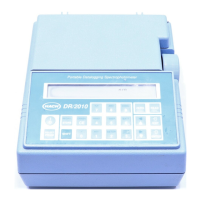56
3.7.4 Printing User Programs
To have a written copy of a user program for reference, the program must
be completed and stored first (see section 3.9 Storing User Programs).
1. Press
SHIFT USER PRGM. Scroll to the Edit Program option. Press ENTER.
The display will show (For example):
2. Select the desired user program number (scroll or use
NUMERIC keys).
3. Press
ENTER. The display will show the program name.
4. Press
SHIFT PRINT. The display will show (for example):
To print the calibration table and other information about the program
press
ENTER. To print the calibration table, the calibration curve and
the other information about the program, press the
DOWN ARROW.
Printing the calibration curve is highly suggested, especially for
quadratic and cubic fits. A visual review is better than comparing r
2
correlation coefficients. The display will show (for example)
5. Press
ENTER.
6. The display will show
PRINTING....and return to the program
name. Figure 17 shows the text printout for a user program.
The equations and coefficients in the software are of the form: Conc = f(Abs).
That is, concentration is a function of absorbance. The graphs, however, are
plotted using the inverse relationship. Absorbance is on the y-axis and
concentration is on the x-axis, implying an Abs = f(Conc) relationship.
nm
+8.8.:8.8.
ÿÿÿÿÿÿÿÿÿÿÿÿÿÿÿÿ
888540
*
Edit Prçm:968
nm
+8.8.:8.8.
ÿÿÿÿÿÿÿÿÿÿÿÿÿÿÿÿ
888540
*0.16
Print Text
nm
+8.8.:8.8.
ÿÿÿÿÿÿÿÿÿÿÿÿÿÿÿÿ
888540
*0.16
Print Graðhics

